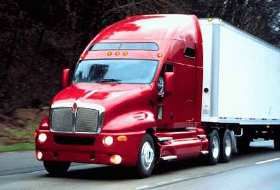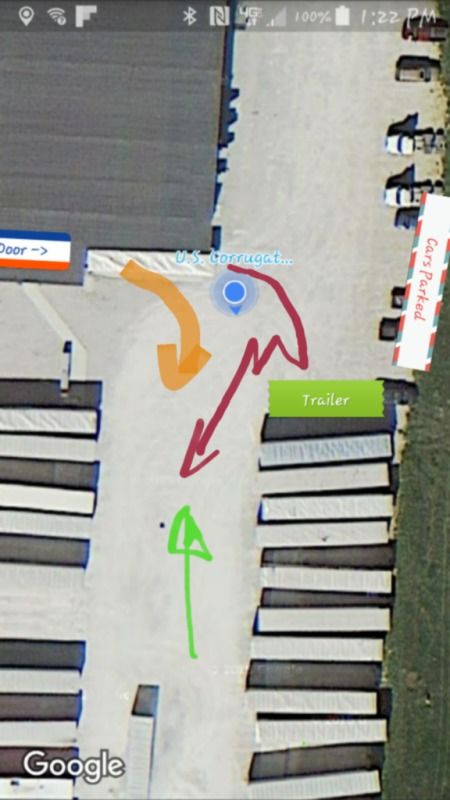Backing™ Practice™ 05™
Topic 13143 | Page 2

This is a really good one Errol, because at first glance it looks like cake. Keep 'em coming...fun puzzles.

Right now I have been sitting in stopped traffic for over an hour. This is US 35, coursing along the Kanawha River Valley, through the Appalachians, so there is no alternative right now. (BTW, I went off duty, and took my 30 minute break already.)
Through Tman's details I think he's close to what I did.
Take a close look at the relation of the building to the door. Make believe the building side is actually a trailer, and you have a 90° alley dock, that we all know and love!
With the cars in front of the dock like that, I couldn't make a complete backing to get to the doc but with a little pull up and some adjustment I got in there.
To get out, I used a trick my mentor showed me. I pulled out and turned hard right which put my cab pointing right at that green trailer. So I turned the wheel hard left, backed up just a few feet, turn the wheel a hard right, pulled forward and did that back up one more time until the cab came around and could pass in front of the green trailer. The only problem to do that is don't jackknife your truck so tight that the wind fairing on the cab crushes into the trailer! Then you have some 'splaining to do!
Errol- these are great. I'll bet there's alot of people like me who don't post, but they work it out in their head, and look forward to the solutions given. BUT
Would you create picture(s) with arrows for entrance and exit solutions? That would really clarify your words. Thanks teach.
Remember- always have KISS your pocket.

Meant to write "KISS in your pocket"
Jet-guy advises:
have KISS your pocket.
I like this better.

Remember, there's rarely only one "correct" way to park or to dock. If you can do it without crunching or knocking anything over, you're good!
Here's a diagram of my exit. Backing in was simply an alley dock around the corner of the building. Getting out required a little "see-saw" action to get the cab past the end of the green trailer.
The thin red line is how the cab went, the wider orange line is the tandems following along.

Tandems:
Tandem Axles
A set of axles spaced close together, legally defined as more than 40 and less than 96 inches apart by the USDOT. Drivers tend to refer to the tandem axles on their trailer as just "tandems". You might hear a driver say, "I'm 400 pounds overweight on my tandems", referring to his trailer tandems, not his tractor tandems. Tractor tandems are generally just referred to as "drives" which is short for "drive axles".
Tandem:
Tandem Axles
A set of axles spaced close together, legally defined as more than 40 and less than 96 inches apart by the USDOT. Drivers tend to refer to the tandem axles on their trailer as just "tandems". You might hear a driver say, "I'm 400 pounds overweight on my tandems", referring to his trailer tandems, not his tractor tandems. Tractor tandems are generally just referred to as "drives" which is short for "drive axles".
OWI:
Operating While Intoxicated
Earlier I wrote:
Right now I have been sitting in stopped traffic for over an hour. This is US 35, coursing along the Kanawha River Valley, through the Appalachians, so there is no alternative right now. (BTW, I went off duty, and took my 30 minute break already.)
I say on that two lane road for nearly 4 hours. My original plan was an 7 hour drive to the consignee. Quick, what's 4 + 7?
I discussed the situation with my DM.* I decided to go for it. I was over my 14 by seven minutes. I plan to do my 10 hours at the destination.
* If you end up going into an HOS violation like this, be sure to discuss it with your DM or FM ahead of time. I didn't mind the few minutes overage because I had spent four hours sitting earlier in the day.
Consignee:
The customer the freight is being delivered to. Also referred to as "the receiver". The shipper is the customer that is shipping the goods, the consignee is the customer receiving the goods.
Dm:
Dispatcher, Fleet Manager, Driver Manager
The primary person a driver communicates with at his/her company. A dispatcher can play many roles, depending on the company's structure. Dispatchers may assign freight, file requests for home time, relay messages between the driver and management, inform customer service of any delays, change appointment times, and report information to the load planners.Fm:
Dispatcher, Fleet Manager, Driver Manager
The primary person a driver communicates with at his/her company. A dispatcher can play many roles, depending on the company's structure. Dispatchers may assign freight, file requests for home time, relay messages between the driver and management, inform customer service of any delays, change appointment times, and report information to the load planners.HOS:
Hours Of Service
HOS refers to the logbook hours of service regulations.
Remember, there's rarely only one "correct" way to park or to dock. If you can do it without crunching or knocking anything over, you're good!
Here's a diagram of my exit. Backing in was simply an alley dock around the corner of the building. Getting out required a little "see-saw" action to get the cab past the end of the green trailer.
The thin red line is how the cab went, the wider orange line is the tandems following along.
I don't know if the "colored lines" helped anyone else, but they did help me.
Tandems:
Tandem Axles
A set of axles spaced close together, legally defined as more than 40 and less than 96 inches apart by the USDOT. Drivers tend to refer to the tandem axles on their trailer as just "tandems". You might hear a driver say, "I'm 400 pounds overweight on my tandems", referring to his trailer tandems, not his tractor tandems. Tractor tandems are generally just referred to as "drives" which is short for "drive axles".
Tandem:
Tandem Axles
A set of axles spaced close together, legally defined as more than 40 and less than 96 inches apart by the USDOT. Drivers tend to refer to the tandem axles on their trailer as just "tandems". You might hear a driver say, "I'm 400 pounds overweight on my tandems", referring to his trailer tandems, not his tractor tandems. Tractor tandems are generally just referred to as "drives" which is short for "drive axles".
OWI:
Operating While Intoxicated
New Reply:
New! Check out our help videos for a better understanding of our forum features

















Preview:
This topic has the following tags:
Backing Challenges Tips For Backing Truck Driver Training







 TT On Facebook
TT On Facebook
That's what I would have done. Of course, pulling a flatbed in a tractor with no fairings and with the fifth wheel set back far enough, you don't really need to worry about the jackknife as much!